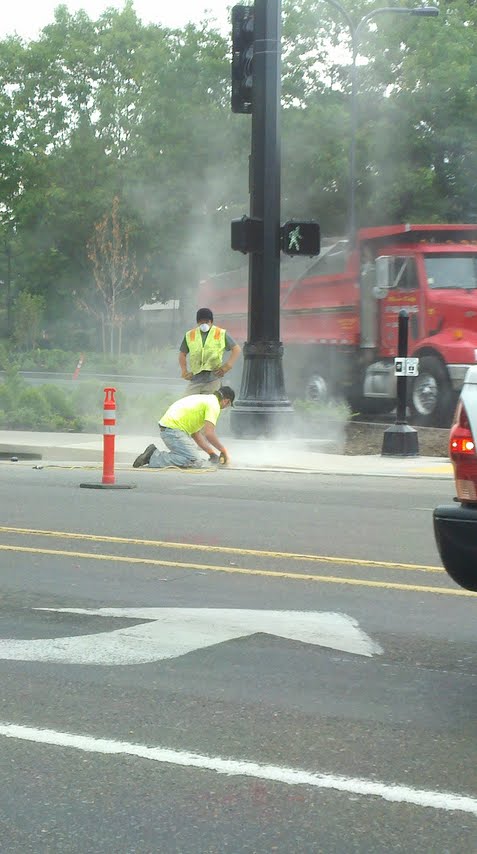Entries tagged with “grinding”.
Did you find what you wanted?
Wed 12 Dec 2012
Posted by admin under Air Monitoring, Behavior Based, Concrete, Dust, Engineering Controls, Exposure, Hazard Communication, HEPA, Management, Personal Protective Equip (PPE), Respirators, Safety Policies, Safety Programs, Silica, Training
Comments Off on Pre task planning – for silica
Controlling most of these types of exposures is really simple. If you know the job- and you know it will generate airborne silica = Pre Task Plan!
I wish Superintendents would enforce their project managers, or project engineers, to make a pre-task plan for every concrete/silica producing task. Then, (please don’t stop yet), review the plan once the project starts!
Below are two examples with different outcomes: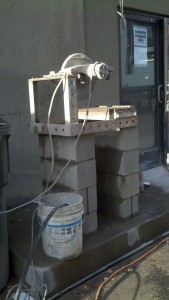
1. Cutting concrete block.
The pretask plan called for a garden hose with attachment(s) to wet the cutting area. Everything was perfect until the water was shut off. But, they improvised and found an electric water pump with bucket and recycled the water. It was a great outcome. What if the power went out? They could have used a Hudson sprayer.
2. Grinding plaster off a brick wall.
They built an enclosure and containment. They had a negative air machine with HEPA filters. They had a vacuum with HEPA filters, tyvek, 1/2 face respirator, eye protection, etc. But, as they worked the vacuum couldn’t keep up with the amount of dust generated by the 7 inch Bosch grinder. It was really dusty. They worked like this for days. No one onsite saw them because they were in containment. Unfortunately the project is almost over and it could have been better. A simple shroud to the grinder, like this one (no endorcement) might have controlled the dust & silica. Sure, it might have been troublesome to find the exact one, and get a vacuum attachment, and have the extra weight, and ….
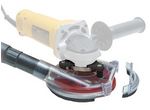
So, let’s talk to people about silica, talk about solutions, and then check to see if they’re effective.
Thu 12 Jul 2012
Living in the NW, stucco is not as prevalent, compared to other areas of the US, as a building material. I finally got the opportunity to perform air monitoring for silica during stucco crack repair. From what the contractor explained, only the top layer of stucco (1/8 inch) is removed. He claimed the top layer is mostly an acrylic. The employee was wearing a 1/2 face tight fitting respirator with P100 (HEPA) cartridges. In addition, engineering controls were used. Â 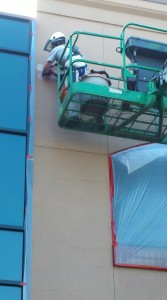 The contractor had a grinder with a shroud and vacuum to remove the dust. This would not be considered a worse-case sampling scenario. From conversations with the plasterer-employees onsite, grinding is usually “VERY dusty”.
The contractor had a grinder with a shroud and vacuum to remove the dust. This would not be considered a worse-case sampling scenario. From conversations with the plasterer-employees onsite, grinding is usually “VERY dusty”.
Sampling performed only for the duration of the grinding (3 hours). Conclusion?: We did not find any detectable levels of silica or respirable dust.
Please don’t use this sampling as the only information on how to proceed for your project. However, here are my observations:
- If acrylic material is the top 1/4 inch, you may not impact silica (or have any airborne).
- Airborne dust was very well controlled by grinder with shroud & vacuum (see pic below).
- Assume you will have dust until you can observe (or prove) otherwise. Wear a respirator.
- Perception is huge. If there is a big dust cloud coming from your grinder—even if there’s no silica… the observers don’t know the difference, and, well,…you know the story.
 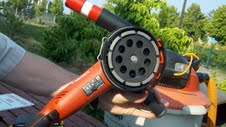
Tue 26 Jun 2012
‘Tis the season for silica (here, and here too).
I had four observations about this picture,
- paper dust masks are totally inadequate for this task, and
- why isn’t there any engineering controls (water?, vacuum?), and
- why is the observer standing in the dust plume?, and
- what does the employees do with their clothes after work?
Please be safe out there.
